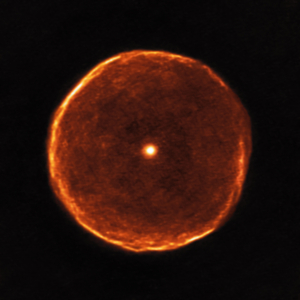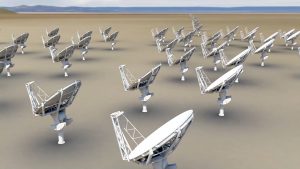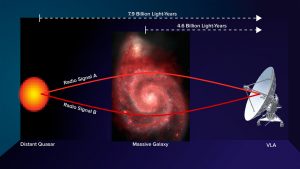This ALMA image reveals much finer structure in the U Antliae shell than has previously been possible. Around 2700 years ago, U Antliae went through a short period of rapid mass loss. During this period of only a few hundred years, the material making up the shell seen in the new ALMA data was ejected at high speed. Examination of this shell in further detail also shows some evidence of thin, wispy clouds known as filamentary substructures.


VLASS Sharpens the View
The new VLA Sky Survey (VLASS) sharpens the view. Here is the same radio-emitting object as seen, from left to right, with the NRAO VLA Sky Survey (NVSS), the FIRST Survey, and the VLASS. The VLASS image, unlike the others, allows astronomers to positively identify the image as jets of material propelled outward from the center of a galaxy that also is seen in the visible-light Sloan Digital Sky Survey. Technical data: NVSS image at 1.4 GHz in VLA’s D configuration; FIRST image at 1.4 GHz in B configuration; VLASS image at 3 GHz in B configuration.

Planning Begins For Next Leap Forward in Research Capability
The National Radio Astronomy Observatory (NRAO) and Associated Universities, Inc. (AUI) are launching a new initiative to design a next-generation radio telescope with scientific capabilities far beyond those provided by any existing or currently proposed observatory. Building on the success of one of the National Science Foundation’s (NSF) flagship observatories, the Karl G. Jansky Very Large Array (VLA), NRAO and AUI are beginning a two-year project to explore the science opportunities, design concepts, and technologies needed to construct a new class of radio telescope. This proposed array, consisting of more than 200 antennas, would extend across the desert southwest of the United States and into northern Mexico. Currently dubbed the next-generation Very Large Array, or ngVLA for short, the new research facility will be designed to provide the next leap forward in our understanding of planets, galaxies, black holes, and fundamental physics.

Measuring Magnetic Fields
Artist’s conception of gravitational lens arrangement that allowed astronomers to measure a galaxy’s magnetic field. Magnetic fields affect radio waves that travel through them. Analysis of the VLA images showed a significant difference between the two gravitationally-lensed images in how the waves’ polarization was changed. That means, the scientists said, that the different regions in the intervening galaxy affected the waves differently.

Saturn’s Moon Offers Glimpse of Earth’s Primordial Past
Archival ALMA data have confirmed that molecules of vinyl cyanide reside in the atmosphere of Titan, Saturn’s largest moon. Titan is shown in an optical (atmosphere) infrared (surface) composite from NASA’s Cassini spacecraft. In a liquid methane environment, vinyl cyanide may form membranes.

Heart of an Exploded Star Observed in 3-D
Remnant of Supernova 1987A as seen by ALMA. Purple area indicates emission from SiO molecules. Yellow area is emission from CO molecules. The blue ring is Hubble data that has been artificially expanded into 3-D.





